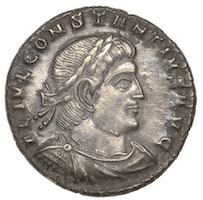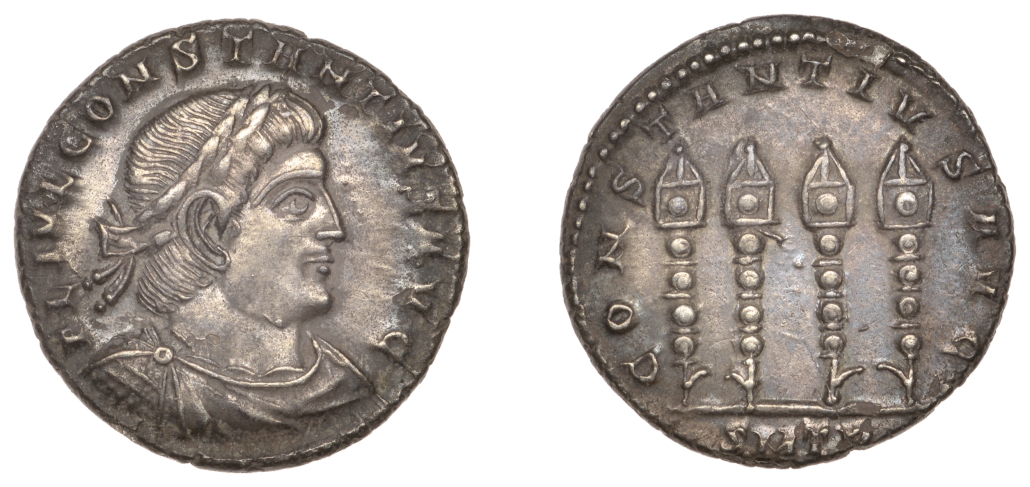
LONDON – A hoard of 142 Roman silver coins that was unearthed in September 2020 was auctioned on May 17 for a hammer price of £81,160 (about $101,000) at Noonans (previously Dix Noonan Webb). Dubbed the Vale of Pewsey hoard, it was 100% sold and had been estimated at £30,000-£40,000.
Mick Rae, a 63-year-old herds manager, Robert Abbott, a 53-year-old who owns a computer shop, and Dave Allen, a 59-year-old carpenter, were spending the weekend camping at a field in Wiltshire, England in September 2020. Allen and Abbott both live in Essex, England, and Rae, at the time, lived in Wiltshire.
Abbot explained: “Having finished breakfast first, I turned on my machine, a Minelab Equinox 800, and having walked around six paces from the tent, I found several tent pegs, and just under the surface a late Roman silver siliqua in pristine condition. A few moments later, beside it, I found another one.”
This prompted both Rae and Allen to grab their detectors to help search. During the course of the weekend they found 161 coins in total, comprising silver siliqua and miliarense dating from the years 340 to 402. The men had to keep the coins in their camping washing-up bowl as they didn’t have anything else to store them in.
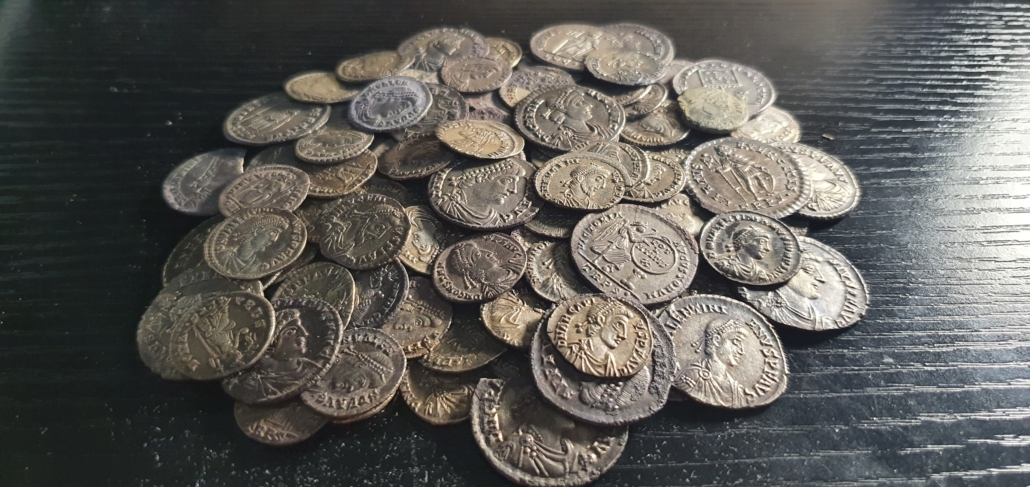
The Vale of Pewsey hoard, discovered in Wiltshire, England in September 2020, consists of 142 Roman silver coins. Image courtesy of Noonans
Abbott continued: “Ironically, we had been camping there two weeks previous for a week-long detecting outing. What we hadn’t realized is we’d actually camped right on top of the area where the coins were found.”
After the auction, Abbott said: “Wow, I am gobsmacked, this is the first auction that I have ever been to, so to see my own items sell so well was amazing. Dave and I sat there watching the prices go up and up. We will obviously share the sale proceeds with the landowner, but I know Mick will spend his money on his new micro-dairy, while I will buy a new camera.”
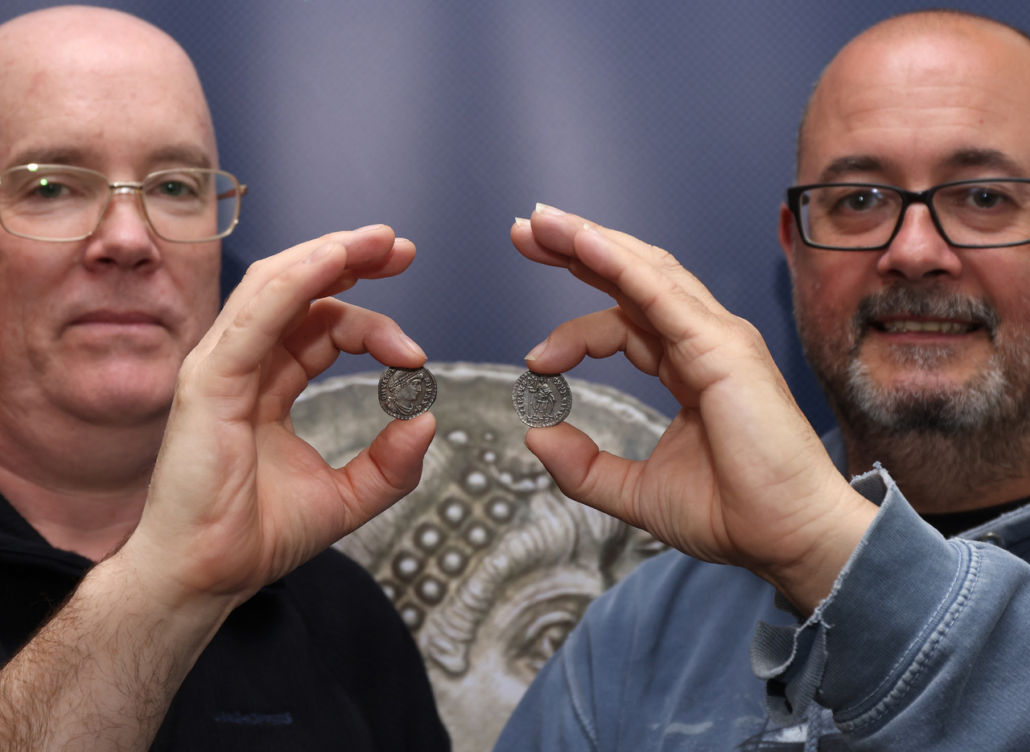
Dave Allen (left) and Rob Abbott (right), two of the three men who discovered the Vale of Pewsey hoard of Roman silver coins, pose with two examples. Image courtesy of Noonans
Noonans Consultant for Artefacts and Antiquities Nigel Mills explained: “Virtually all of the coins were in mint condition and have not even needed to be cleaned since their discovery. The hoard was buried at a time when Roman rule in Britain under the Emperor Honorius was no longer viable, with the army being recalled to protect other provinces. In 410, Britain was told to protect itself by Honorius.” He added: “As a result, Britain has become a treasure island of late 4th century and early 5th century gold and silver Roman coin and jewelry hoards as the local population buried their valuables and then fell victim to Saxon raids. Detector finds in recent years include the Thetford and Hoxne hoards.”
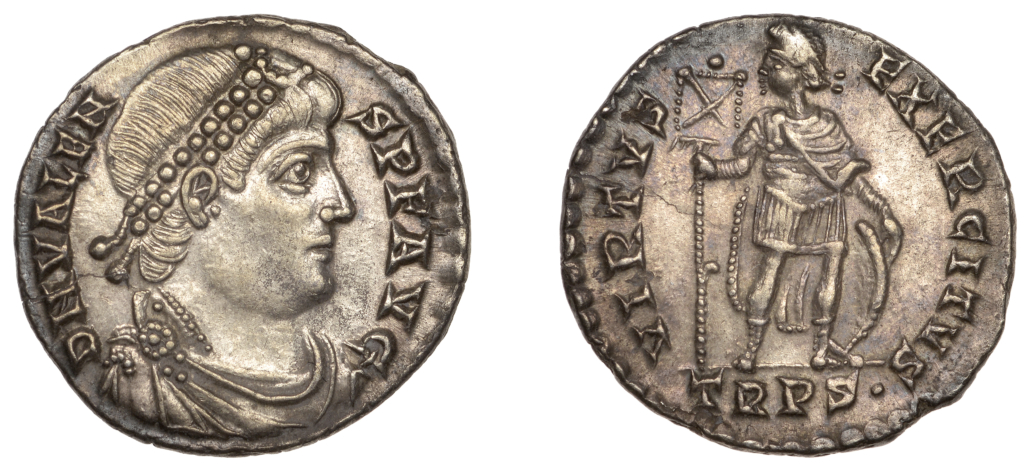
After the sale, Mills said: “The sale was really well supported and made double its high estimate. We had buyers from the USA, Germany, Malaysia and the UK, and everyone is very happy with the outcome – it just shows what can be achieved if you do all the right things.”
The two highest prices of the sale were for two Miliarensis coins. An extremely fine example from the reign of Valens (364-378) realized £4,200 against an estimate of £1,200-£1,500, while an extremely rare example from the reign of Constantius II (337-361) achieved £4,000 against an estimate of £2,000-£2,600.
The British Museum studied the coins and retained just two from the hoard for their collection.
[av_button label=’Click to view the auction catalog complete with prices realized’ icon_select=’no’ icon=’ue800′ font=’entypo-fontello’ link=’manually,https://www.liveauctioneers.com/catalog/248224_vale-of-pewsey-hoard-of-roman-silver-coins/’ link_target=’_blank’ size=’small’ position=’center’ label_display=” title_attr=” color_options=” color=’theme-color’ custom_bg=’#444444′ custom_font=’#ffffff’ btn_color_bg=’theme-color’ btn_custom_bg=’#444444′ btn_color_bg_hover=’theme-color-highlight’ btn_custom_bg_hover=’#444444′ btn_color_font=’theme-color’ btn_custom_font=’#ffffff’ id=” custom_class=” av_uid=’av-6bkfumr’ admin_preview_bg=”]
The current rate of exchange is £1 = $1.23.
View top auction results on LiveAuctioneers here: https://www.liveauctioneers.com/pages/recent-auction-sales/


